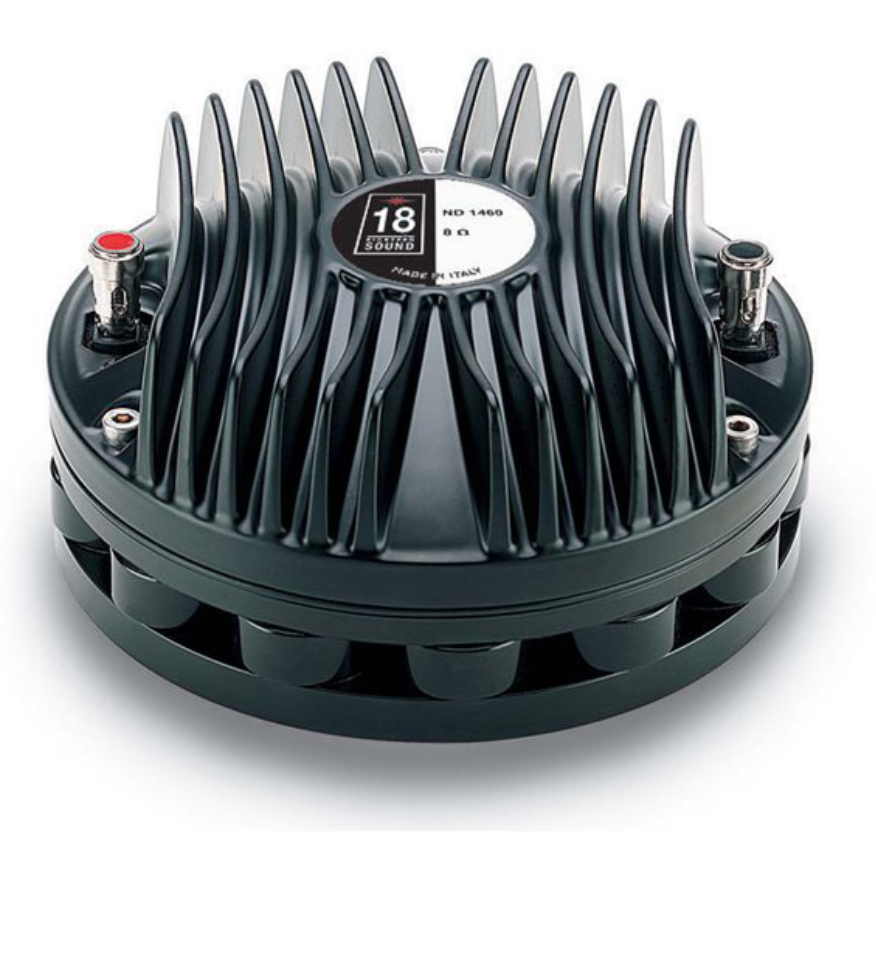 In this blog post I test the 18Sound ND1460 1.40" compression driver featuring 3" titanium diaphragm and a copper shorting ring in the magnetic gap.
In this blog post I test the 18Sound ND1460 1.40" compression driver featuring 3" titanium diaphragm and a copper shorting ring in the magnetic gap.
I mounted the driver to my ES290 Biradial No.1670 which features an exponential flare rate and 300Hz cutoff frequency (Fc).
The ND1460 retails each for €600.00 ($667 USD) or $882 CAD.
A customer sent me this driver for evaluation.
Let's start by looking at the published data which shows an excellent frequency response that is free from any abrupt irregularities in the response until breakup at 12kHz.

The impedance sweep shows the FS centered at 550Hz with a completely flat passband. Could the copper shorting ring be really working its magic here? There is also an absence of breakup in the upper treble.

Hopefully the published data is more representative of actual performance for this particular model after testing the ND1TP here which showed pretty heavy smoothing and embellishment of the test data from the manufacturer.
Impedance Sweep
Starting with the impedance sweep as measured we can see that the FS is centered at around 500Hz.
2.2kHz shows a narrow peak indicating some sort of a resonance. There is a small breakup at 12kHz and a stronger breakup at 17kHz. It would have been nice to see this on the published impedance sweep.

Frequency Response
The measured frequency response shows very linear behavior with a small -2dB shelf at 2.2kHz (see impedance plot). The small breakup at 12kHz result in a drop in the response which is nice to see compared to most drivers which have a peak in the response near breakup.
Extending the graph out to 50kHz reveals a gradual but steep roll-off above the 17kHz breakup. Everything seems pretty benign in terms of severity.
Time Domain
As expected from the frequency response above, we can see that the burst decay shows relatively benign resonances which only really show up in above 12kHz, an excellent result.
The CSD plot again shows little to report with everything coming to settle in under 0.25 millisecond.
Distortion
Harmonic was tested at 85 and 95dB which shows average distortion performance for this type of driver. Normally we would want to see H2 lower than 0.10% for the 85dB test signal.
Intermodulation Distortion
Normally we would want to see IMD at -70dB or better for the 85dB test signal level. However we see only -60dB at the 1.8kHz region. Things improve to -68dB by 3kHz. Upper treble is free from IMD rise that I see with many other drivers indicating potentially clean treble performance.
The 95dB test signal sees IMD rise in a linear fashion as expected. We are 10dB shy of our target for sound quality for home audiophile applications, at least through the critical midrange (1.5kHz).
Gedlee Metric (Gm)
I tested Gm with a 95dB test signal at both 1kHz and 10kHz. THD-A is the same for both test frequencies. However Gm is half the value at 10kHz. This may be due to the fact that Gm is looking for the higher order harmonics to weight its value, which simply are completely outside the bandwidth of the system.
1kHz result:

10kHz result:

Subjectively Listening Impressions
I listened to the ND1460 with the 1798 bass cabinet crossed over at 500Hz. Starting with the midrange I found that it struggled to provide the clarity and sense of dynamice range of the larger format compression drivers such as the B&C DCM50, DCX464, BMS 4590, 4591, and RCF ND950. It revealed to me that this driver is more suitable for smaller horns such as the ES-600 Biradial. I did not have this problem with the RCF ND850 even though they share the same size diaphragm.
Moving onto the treble performance I was pleasantly surprised by the amount of treble detail and extension offered by the ND1460. I even tried boosting the treble using the 10 band EQ feature in the WiimPro app. Even with +6dB boost at 16kHz the treble was not objectionable. But overall I found the driver to lack some smoothness both in the midrange and treble. There was also some lack of clarity and dynamics through the midrange compared to the RCF ND850 and ND950, although the ND1460 was a little more resolved in the treble performance than the RCF ND950 which has a 4" diaphragm compared to the ND1460's 3" diaphragm.
Conclusion
The 18Sound ND1460 offers a very flat and trouble free frequency response which is almost as good as published, however if falls short in the clarity and dynamics department especially though the midrange. I directly compared this driver to the RCF ND950 and immediately found the RCF to have a little more dynamics and clarity. The 18Sound ND1460 does have good treble performance making it suitable for 2-way applications, however it does fall short for critical applications like audiophile 2-channel music.








